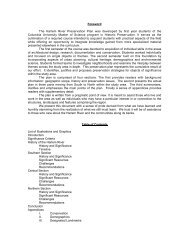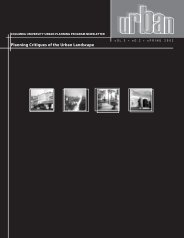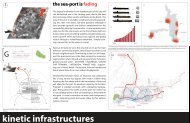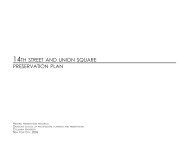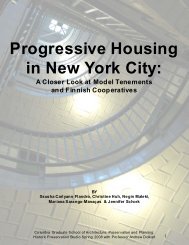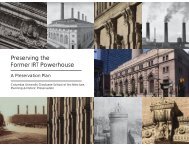The Art of Planning - Columbia University Graduate School of ...
The Art of Planning - Columbia University Graduate School of ...
The Art of Planning - Columbia University Graduate School of ...
You also want an ePaper? Increase the reach of your titles
YUMPU automatically turns print PDFs into web optimized ePapers that Google loves.
ASK A PRO-FESSOR - Urban <strong>Planning</strong>: art or science?<br />
10<br />
Is urban planning an art that uses scientific tools, a science that requires a bit <strong>of</strong><br />
creativity to get the job done well, both, or neither? We put our faculty to the test<br />
with this <strong>of</strong>ficially artful, non-scientific think-piece. URBAN asked them to discuss<br />
briefly the nature <strong>of</strong> the planning field, and the creative and/or scientific methods<br />
employed in the planning process. Here’s what they had to say:<br />
Elliott Sclar<br />
To be a good urban planner you need to develop an urban imagination. What I call an<br />
urban imagination is a variant on what the late <strong>Columbia</strong> <strong>University</strong> sociologist, C. Wright<br />
Mills called a sociological imagination. Mills meant the ability to see the impact <strong>of</strong> broader<br />
historic forces on the lives <strong>of</strong> individuals. I mean the ability to see the historic process<br />
through which the social and physical elements <strong>of</strong> the urban context evolved. It is easy<br />
to walk out <strong>of</strong> the gates <strong>of</strong> the campus and take the urban reality that confronts you as<br />
something that is just there. But it is important to remember that the people on the street as<br />
well as the buildings, traffic lights, median plantings, etc. are all there as a result <strong>of</strong> myriad<br />
individual decisions. While the decisions are individual, the historic forces behind them<br />
are all social in nature. <strong>The</strong> urban fabric in both its social and physical manifestations is<br />
not static. It is an ever-changing mosaic <strong>of</strong> people, buildings, and infrastructure. It is this<br />
dynamism that creates the vitality that has been luring people to cities for over 10,000<br />
years. As you stand at Broadway and 116 th Street, you know that somewhere people who<br />
will change what you see are on their way. <strong>The</strong>y are coming for a variety <strong>of</strong> reasons. But<br />
once they arrive, they will change the scene on the street, some will change the buildings,<br />
and others the infrastructure.<br />
You as an urban planner do not need to understand all those countless decisions, but<br />
you do need to understand how larger forces <strong>of</strong> the economy, governance and social life<br />
are driving the options from which the ultimate decisions are made. To have an urban<br />
imagination is to have the ability to understand how these larger forces will alter the urban<br />
fabric. <strong>The</strong> most important things you will need are the ability to give language or graphic<br />
representation to the processes you are observing. <strong>The</strong> social sciences, and even the<br />
physical sciences, can help you a little in this regard. <strong>The</strong> ability to see new physical options<br />
is also a useful tool. <strong>The</strong> courses you take, the conversations you have with your fellow<br />
students and pr<strong>of</strong>essors, are all part <strong>of</strong> the process <strong>of</strong> creating your urban imagination.<br />
Each <strong>of</strong> us develops our own imagination and narrative to explain it. <strong>The</strong>re are no right<br />
and wrong answers here; just good ones and better ones. <strong>The</strong> first step in developing your<br />
urban imagination is to remember that every<br />
time your eyes take in an urban scene, you will<br />
try to imagine all the events and decisions that<br />
had to be made to create that reality. You also<br />
need to remember that the reality that you are<br />
beholding is changing even as you stare at it.<br />
Floyd Lapp<br />
Forty-five years ago, when I started studying<br />
planning, there was a major move toward the<br />
use <strong>of</strong> mathematical models to predict travel<br />
Photograph by Minna Ninova<br />
behavior, urban form, and shape. It hasn’t worked.<br />
As we seek to define the problem, identify the alternatives, project the outcomes, and<br />
decide among alternatives, the planner cannot really be comprehensive. Herbert Simon<br />
was right when he said that decision-making cannot be made processing and obtaining all<br />
information since we lack that capacity. Instead, we make planning decisions on the basis<br />
<strong>of</strong> “satisficing.” That is, we take a course <strong>of</strong> action that is ‘good enough.’<br />
In a <strong>Columbia</strong> studio I supervised that dealt with the future <strong>of</strong> the Tappan Zee Bridge, the<br />
students reviewed and decided upon various options: build new or rehab; select one or<br />
more forms <strong>of</strong> transit for the bridge based upon generally accepted criteria; and put the<br />
transit in the context <strong>of</strong> a low-density suburban environment with rugged topography. <strong>The</strong><br />
students recommended building a new bridge with bus rapid transit because it provided<br />
the extra dimension <strong>of</strong> flexibility that light and heavy rail lacked on a fixed right <strong>of</strong> way.<br />
As a practitioner at the New York City Department <strong>of</strong> City <strong>Planning</strong>, our team selected the<br />
best rail route to LaGuardia Airport based upon the following criteria: a route with access<br />
to midtown west and east, and also lower Manhattan, which is where most <strong>of</strong> the trips<br />
are located ; a route that travels through one <strong>of</strong> the four East River tunnels that has the<br />
least subway congestion and is most proximate to the airport. As a result, the ‘N’ train was<br />
selected.<br />
<strong>The</strong> art form has to do with Simon’s “satisficing” and doing the best we can to select the<br />
criteria that seem to work rather than merely running a quantitative model that lacks the<br />
touch and feel <strong>of</strong> the people it is designed to serve.<br />
URBAN



